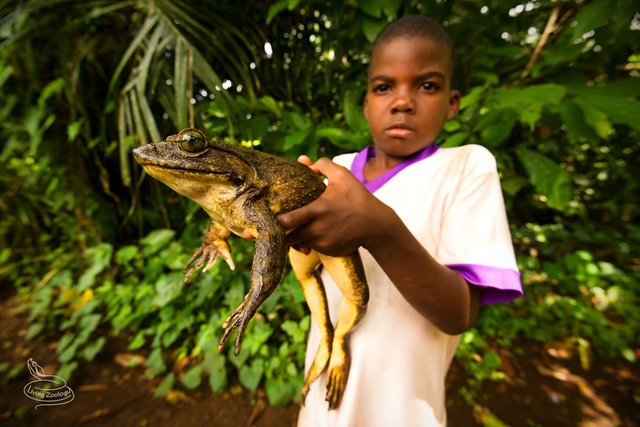The amphibian family may be facing the current mass extinction chapter more than any other wildlife family. Approximately there exist an estimated 7,635 described amphibian species worldwide (IUCN Red list 2017). Virtually all these species are dependent on water and terrestrial habitats for their survival. It, therefore, implies that the survival of their populations depends on ample, suitable terrestrial habitats adjacent to suitable aquatic breeding sites. This combination of habitat requirements makes amphibians most vulnerable to anthropogenic habitat alteration. According to IUCN Red list of 2017, amphibians are far more threatened than either birds or mammals. At least 2,469 (43%) out of the estimated 7,635 species of amphibians are experiencing some sort of decline.
Populations are declining fast
Amphibians worldwide are declining at an alarming rate. While updates to the amphibian database is a continual process, there has not been a major comprehensive amphibian assessment completed by the Global Amphibian Assessment (GAA) since 2004. Since 2004 there have been two updates of the data, one in 2006, and the most recent in 2008. According GAA updates in 2008 32% of amphibian species threatened with extinction compared to 23% of mammals and 12% of birds. 160 are believed to have already gone extinct. These statistics are fuel by habitat loss (deforestation), changes in water or soil quality and the potential impacts of climate change. In addition many species are suffering from an epidemic caused by a chytrid fungus.

Goliath frog - the biggest frog on the Earth (picture made by our friends from LIVING ZOOLOGY - just trying to convince them to join steemit)
Amphibians for people
Amphibians have greatly enhanced human lives though their services are always under estimates in the ecosystem. Amphibians can influence regulating services by altering disease transmission and pest outbreaks through predatory effect. Predatory amphibians help reduce the spread of mosquito-borne illness through predation and competition with mosquitoes. Amphibians contribute to provisioning services through food and medicine; Amphibians also use chemicals for a number of purposes including mating activity, territorial marking, predator defence, and combating microbial infections. These chemicals provide potential starting points for new drugs. Amphibian species have a high potential as indicator species. Their biphasic lifestyle, together with their high sensitivity towards environmental changes makes them good environmental tools in the assessment of habitat quality.
Let’s save Amphibian species in Cameroon together
Cameroon is bless to be counted as one of the richest countries for amphibian diversity. Its volcanic line is one of Africa’s biodiversity hotspots, hosting many endemic species. Field observations in Cameroon over the last decades indicates that several montane frog species are becoming difficult to see or even impossible to find. Mt Oku located in the Bamenda highland is one montane forest facing this problem. In a bite to help solve this problem Kedjom- Keku CASUD is educating communities on the importance of this species to the ecosystem and also helping in restoring degraded water course which are vital for their survival. Help us to help this very importance and charismatic species gain their rightful place in the environment.
Manka Grace
@manka (read more about me here)
content creator of @kedjom-keku association and fund-raising and upvoting bot @treeplanter
member of Forest Friendly Family
Our Steemit team:
@martin.mikes - coordinator/co-founder of @kedjom-keku, @treeplanter and Forest Friendly Family
@thegreens - partner
@raserrano - IT specialist (admin of @treeplanter)
sources:
Numbers of threatened species by major groups of organisms (1996–2017)
Measuring the Meltdown: Drivers of Global Amphibian Extinction and Decline
Global Amphibian Assessment
Amphibian Contributions to Ecosystem Services
Dramatic Declines of Montane Frogs in a Central African Biodiversity Hotspot
More opportunities how to help
Contribute to our transparent accounts
| EUR | IBAN: CZ8120100000002401262246 | BIC/SWIFT: FIOBCZPPXXX |
| USD | IBAN: CZ9020100000002801262245 | BIC/SWIFT: FIOBCZPPXXX** |
 |  | 1GVCsYsf2LzvyqDUYhXPjQbb2KtW6dDDH |
 |  | 8LsW14JHnbvpq6RefqASJMgySN6K8SgAiG |
 |
![]() Plant trees with our voting bot @treeplanter!
Plant trees with our voting bot @treeplanter!
 Check or website: www.kedjom-keku.com to get more information about our conservation program in Cameroon.
Check or website: www.kedjom-keku.com to get more information about our conservation program in Cameroon.
Keep posting, I'm here with you.
Downvoting a post can decrease pending rewards and make it less visible. Common reasons:
Submit
Thank you. Am glad to know you are with us
Downvoting a post can decrease pending rewards and make it less visible. Common reasons:
Submit
good job ure doing
Downvoting a post can decrease pending rewards and make it less visible. Common reasons:
Submit
Thank you
@manka
content creator
Downvoting a post can decrease pending rewards and make it less visible. Common reasons:
Submit